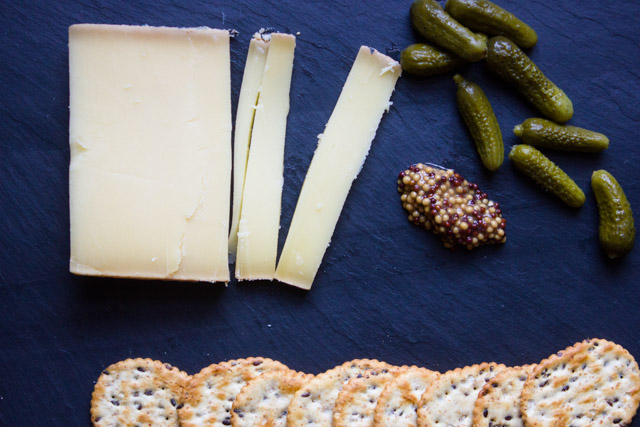Chicagoist's Cheese Of The Month: Comté
By Erika Kubick in Food on Sep 4, 2014 9:30PM

(Photo: Erika Kubick for Chicagoist)
Fall is coming: the air is ripe with the aroma of apples and it’s time to move on from the soft, summery fresh cheeses to something more complex. Let’s talk about a cheese with 83 distinct flavors including toasted bread, apricot and chocolate. Let’s talk about the most popular AOC* cheese in France. Let’s talk about Comté.
Comté is the French "brother from another mother" version of the Swiss Gruyère. This cheese is made from raw cow’s milk. The recipe is the same: the curds are cut into grains the size of rice, cooked and pressed. Traditionally made from the summer milk of the pasture-fed Montbeliarde or French Simmental breeds of cow, Comté is just right for the coming autumn.
In addition to maintaining its status as the most popular fromage in France, Comté also has the highest production. Jura, the Comté-producing department of Franche-Comté, is a tiny area in the middle of the eastern side of France that has produced Comté since the 12th century. Today, the region produces about 40,000 tons annually - and there is still a shortage due to high demand.

(Photo: Erika Kubick for Chicagoist)
On average, the wheels are about 70 centimeters in diameter and 80-110 pounds. The rind is usually a dusty brown with a smooth and toothsome paste under the crust. Comté is aged anywhere from four months to as long as four years. Younger wheels have a soft texture with notes of fresh milk while older wheels boast deeper, caramelized flavors and a strong but sweet bouquet. Whether old or young, Comté is characteristically sweet and nutty with a floral, fruity note that lingers on the palate. Not all Comté is created equal: the best of the best Comté is known as Comté extra, while wheels with slight flaws like cracks and small holes are simply Comté. The very least pristine is sold as gruyère. Some Comté will have tiny crunchy specks in the paste, which are amino acid crystals called tyrosine. This is a sign of an exquisite Comté.
Comté is a phenomenal addition to any cheese plate, but also shines in cooking applications like mornay and fondue sauces. Pair it with tart jams or zesty mustards, cornichons and fatty charcuterie. When it comes to beverage pairings, the complex flavors of Comté blend beautifully with old world chardonnays, especially champagne, Rhone Valley reds, and cider. I snacked on Comté alongside a glass of Ledbury by Virtue Cider, a medium-bodied British style ale with a touch of farm-y funk, and a slab of pâté from Butcher & Larder (1026 N Milwaukee Ave).
You can find Comté almost anywhere artisanal cheese is sold: Mariano's, Whole Foods, Pastoral, Marion Street Cheese Market and Eataly.
*AOC regulations were established in France to define the quality standards of the nations products, such as cheeses and wine. The regulations stipulate the origin of milk, the geographic region, the cheese making and aging process, physical appearance and more. Comté was the second cheese to receive AOC status.